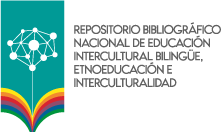Por favor, use este identificador para citar o enlazar este ítem:
http://repositoriointerculturalidad.ec/jspui/handle/123456789/4221Registro completo de metadatos
| Campo DC | Valor | Lengua/Idioma |
|---|---|---|
| dc.contributor.advisor | Simbaña Pillajo, Freddy Enrique | - |
| dc.contributor.author | Cabezas Farinango, Silvia Marlene | - |
| dc.contributor.author | Campués Campués, Rolando | - |
| dc.date.accessioned | 2015-06-30T16:41:35Z | - |
| dc.date.accessioned | 2020-04-29T17:05:19Z | - |
| dc.date.accessioned | 2020-05-04T03:26:38Z | - |
| dc.date.available | 2015-06-30T16:41:35Z | - |
| dc.date.available | 2020-04-29T17:05:19Z | - |
| dc.date.available | 2020-05-04T03:26:38Z | - |
| dc.date.issued | 2015-05 | - |
| dc.identifier.other | http://dspace.ups.edu.ec/handle/123456789/9730 | - |
| dc.identifier.uri | http://8.242.217.84:8080/xmlui/handle/123456789/4221 | - |
| dc.description | Our research on “Intercultural Bilingual Education and the Revitalization of Culture of the People Kayambi , case study in CECIB Arturo Borja community Muyurco parish Olmedo , Canton Cayambe , Pichincha province ," is made in order to determine the reality that is and develops intercultural bilingual education in the institution, taking into account key variables as different forms of community thinking. Intercultural bilingual education over time has engaged and strengthened its presence in the communities, being considered as a collective right of Indigenous Peoples and Nationalities of Ecuador, which in this investigation we determine its contribution to the strengthening of culture through literature research and interviews with primary sources actresses of the educational process. In the first chapter we define the origin of the EIB, the territory of the People Kayambi , and different variables such as: development , progress of Intercultural Bilingual Education System and the different processes that crossed this institution , as well as educational innovations and Education intercultural Bilingual assumes knowledge and wisdom of peoples and nationalities and integrates the rhythm of community life with its stakeholders In the second chapter we know the culture of the Pueblo Kayambi with his form of politics, social organization, its organizational structure, its customs, traditions; festivities also know the story of creation and organizational process CECIB "Arturo Borja". In the third chapter, we will apply the interviews which we will know the contributions and perceptions of different educational actors Intercultural Bilingual Community Learning Centre "Arturo Borja” and so to answer the question posed. | en_US |
| dc.description.abstract | Nuestra investigación sobre “La Educación Intercultural Bilingüe y la revitalización de la cultura del Pueblo Kayambi, estudio de caso en el CECIB Arturo Borja de la comunidad de Muyurco, parroquia Olmedo, Cantón Cayambe, provincia de Pichincha”, fue realizada con el objetivo de determinar la realidad en la que se encuentra y se desarrolla la Educación Intercultural Bilingüe en la institución, tomando en cuenta como variables fundamentales las diferentes formas de pensamiento comunitario. La Educación Intercultural Bilingüe con el paso del tiempo se ha involucra fortalecido su presencia en las comunidades, siendo considerada como un derecho colectivo de los Pueblos y Nacionalidades indígenas del Ecuador, lo que en la presente investigación determinamos su contribución al fortalecimiento de la cultura a través de la investigación bibliográfica y las entrevistas a fuentes primarias actoras del proceso educativo. En el primer capítulo definiremos el Origen de la EIB, el territorio del Pueblo Kayambi, y sus diferentes variables como: desarrollo, avances del Sistema de Educación Intercultural Bilingüe y los diferentes procesos que esta institución a cursado, además las innovaciones pedagógicas y como la Educación Intercultural Bilingüe asume los saberes y las sabidurías de los pueblos y nacionalidades y las integra al ritmo de vida comunitario con sus actores sociales. En el segundo capítulo conoceremos la cultura del Pueblo Kayambi con su forma de organización política, social, su estructura organizativa, sus costumbres, tradiciones, festividades también conoceremos la historia de creación y el proceso organizativo del CECIB “Arturo Borja”. En el tercer capítulo, aplicaremos entrevistas con la cual vamos a conocer los aportes y percepciones de los diferentes actores educativos del Centro Educativo Comunitario Intercultural Bilingüe “Arturo Borja” y así dar respuesta a la interrogante planteada. | en_US |
| dc.format | application/pdf | - |
| dc.language.iso | spa | en_US |
| dc.publisher | Universidad Politécnica Salesiana – UPS | es_ES |
| dc.rights | openAccess | - |
| dc.subject | EDUCACIÓN INTERCULTURAL BILINGÜE | es_EC |
| dc.subject | IDENTIDAD CULTURAL | es_EC |
| dc.subject | CULTURA - EDUCACIÓN | es_EC |
| dc.subject | VIDA SOCIAL Y COSTUMBRES | es_EC |
| dc.subject | KAYAMBI | - |
| dc.subject | PROVINCIA DE PICHINCHA | - |
| dc.title | La educación intercultural bilingüe y la revitalización de la cultura del pueblo Kayambi :Estudio de caso en el CECIB Arturo Borja de la comunidad de Muyurco, parroquia Olmedo, cantón Cayambe, provincia de Pichincha | en_US |
| dc.type | bachelorThesis | en_US |
| dc.ups.carrera | Educación Intercultural Bilingüe | - |
| dc.ups.sede | Sede Quito | - |
| Aparece en las colecciones: | 1.30 Educación | |
Ficheros en este ítem:
| Fichero | Tamaño | Formato | |
|---|---|---|---|
| UPS-QT07661.pdf | 573,52 kB | Adobe PDF | Visualizar/Abrir |
Los ítems de DSpace están protegidos por copyright, con todos los derechos reservados, a menos que se indique lo contrario.
